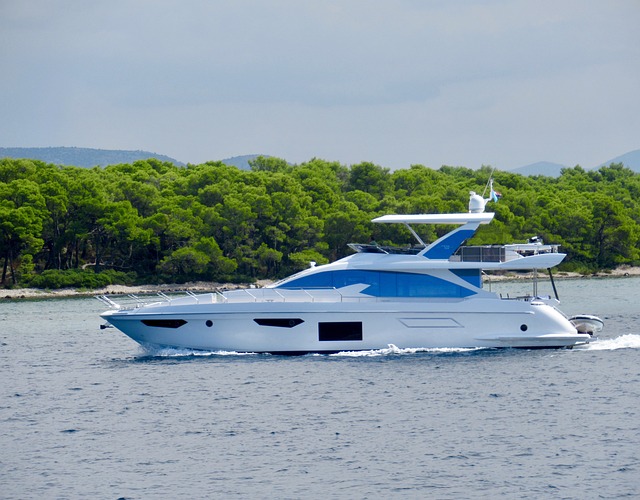Marine battery technology has significantly advanced with lithium-ion batteries emerging as a superior alternative to traditional lead-acid batteries for their environmental benefits. Lithium batteries offer a longer lifecycle, fewer replacements, and less waste, thus reducing the overall environmental impact associated with production, disposal, and recycling. They are more resource-efficient and pose a diminished risk to aquatic ecosystems compared to lead-acid batteries, which contain toxic lead. Lithium batteries lack toxic heavy metals like mercury, cadmium, and lead, thus minimizing pollution risks. Their higher energy density provides more power per kilogram, making them ideal for space-constrained marine vessels. The durability of lithium batteries also means fewer replacements are needed, leading to less waste.
The environmental impact of marine batteries has been scrutinized through lifecycle analysis, with lithium batteries being found more favorable than lead-acid ones due to their lower soil and water pollution during production and the ease of recycling at the end of their life cycle. Lithium batteries facilitate reduced greenhouse gas emissions because their lighter weight translates to less fuel consumption for vessels. Recycling lithium marine batteries can recover up to 95% of valuable materials, a process not feasible with lead-acid batteries due to their toxic nature. Overall, lithium marine batteries present a more sustainable option throughout their lifecycle, offering environmental benefits over lead-acid batteries in maritime applications. Proper disposal and recycling are essential for both battery types to minimize their environmental footprint; however, the recycling of lithium batteries is notably more complex due to the inherent risks involved. The responsible management of marine batteries, regardless of type, is crucial for preserving aquatic ecosystems and promoting sustainability in maritime operations.
marine batteries play a pivotal role in powering a myriad of maritime applications, from leisure craft to commercial vessels. Among the various types available, lithium batteries have emerged as a front-runner due to their superior environmental performance when compared to traditional lead-acid batteries. This article delves into the reasons behind lithium’s eco-friendly edge, examining the lifecycle impact, recycling processes, and disposal considerations that highlight their green benefits in marine contexts. Through a comprehensive analysis, we uncover the environmental advantages of adopting lithium battery technology for maritime energy needs.
- Assessing the Environmental Impact of Marine Batteries: Lithium's Advantage Over Lead-Acid
- Lithium Battery Technology: The Green Alternative for Maritime Energy Needs
- The Lifecycle Analysis of Lithium vs. Lead-Acid Batteries in Marine Applications
- Understanding the Recycling and Disposal Processes of Lithium and Lead-Acid Marine Batteries
Assessing the Environmental Impact of Marine Batteries: Lithium's Advantage Over Lead-Acid

When assessing the environmental impact of marine batteries, lithium-ion technology presents a clear advantage over traditional lead-acid options. The lifecycle of a lithium battery is significantly longer than that of a lead-acid battery, which means fewer replacements and less waste generated over time. This reduction in replacement frequency directly translates to a lower environmental footprint, as the production, disposal, and recycling processes for lithium batteries are less resource-intensive and more efficient compared to their lead-acid counterparts.
Moreover, the environmental consequences of battery disposal cannot be overstated. Lead is a highly toxic substance that can have detrimental effects on aquatic ecosystems if not properly contained. When lead-acid batteries degrade or are improperly disposed of, they pose a significant risk to marine life and water quality. In contrast, lithium batteries contain less hazardous material and are designed with materials that are less corrosive and more biologically inert, thus posing a lower risk to the environment if accidentally released into the marine environment. As such, adopting lithium-ion marine batteries contributes to the preservation of aquatic health and supports sustainable practices within maritime activities.
Lithium Battery Technology: The Green Alternative for Maritime Energy Needs

Lithium battery technology represents a significant leap forward in addressing maritime energy needs with a minimal environmental footprint. Traditional lead-acid batteries have long been the staple for powering vessels, but their lead content poses considerable environmental risks during both use and disposal. In contrast, marine lithium batteries offer a greener alternative, as they are free from toxic heavy metals like mercury, cadmium, and lead—substances that can have detrimental effects on aquatic ecosystems. The environmental advantages of lithium batteries extend to their energy density; they provide more power per kilogram compared to lead-acid equivalents, making them an ideal choice for the weight-sensitive environments typical of maritime applications. Additionally, lithium batteries have a longer operational lifespan and can withstand a higher number of charge/discharge cycles before their performance degrades significantly, reducing the frequency of replacement and associated waste generation. This not only contributes to cost savings over time but also mitigates the environmental impact of battery disposal. The adoption of lithium marine batteries is thus a pivotal step towards sustainable operations in the maritime sector, aligning with global efforts to reduce carbon footprints and protect marine biodiversity.
The Lifecycle Analysis of Lithium vs. Lead-Acid Batteries in Marine Applications

In marine applications, the environmental impact of batteries is a critical consideration due to their long-term deployment and sensitive ecosystems. A comprehensive lifecycle analysis (LCA) reveals that lithium batteries generally outperform lead-acid batteries in terms of environmental friendliness within this context. The production phase of lithium marine batteries typically involves less soil and water contamination compared to traditional lead-acid equivalents. This is primarily due to the more contained nature of lithium battery production processes, which minimize the release of hazardous substances. Furthermore, lithium batteries are significantly lighter, reducing fuel consumption for vessels that rely on their power, thereby lowering greenhouse gas emissions associated with marine travel.
The end-of-life management of lithium marine batteries also presents an environmental advantage over lead-acid batteries. Lithium batteries can be recycled more efficiently, with recycling facilities capable of recovering up to 95% of the materials, including cobalt and lithium, which are critical components for battery performance. In contrast, lead-acid batteries present significant challenges at their end-of-life due to the toxicity of lead, requiring specialized handling and processing to prevent environmental contamination. The overarching findings from lifecycle analyses underscore that, in marine applications, lithium batteries are a more sustainable choice, offering reduced environmental footprints across their entire life span when compared to lead-acid batteries.
Understanding the Recycling and Disposal Processes of Lithium and Lead-Acid Marine Batteries

The environmental impact of marine batteries, both lithium and lead-acid, is a critical aspect to consider in their lifecycle. Lithium batteries have gained prominence in marine applications due to their superior performance characteristics, such as longer life and higher energy density. However, the environmental implications extend beyond usage to encompass recycling and disposal processes.
Upon reaching the end of their service life, lithium marine batteries are subject to specific recycling protocols that differ significantly from those of lead-acid batteries. The recycling of lithium batteries involves carefully handling each component due to the toxicity and reactivity of the materials involved. Facilities recover and process the battery’s lithium, electrolyte, plastics, separators, and metals, aiming to minimize environmental contamination. The recovered metals can be reused in new batteries or other applications, thus closing the loop on material usage.
In contrast, lead-acid marine batteries present a more traditional approach to recycling, which has been established for decades. These batteries contain sulfuric acid and lead dioxide, both of which are hazardous waste materials. The recycling process begins with the safe collection and transportation of spent batteries to specialized processing plants. At these facilities, the batteries are disassembled, and the lead is smelted down to be reused in new battery plates or other lead products. The sulfuric acid is treated to prevent soil and water pollution. While both types of batteries have recycling processes, lithium batteries’ processes are more complex and require specialized handling due to their potentially hazardous components, making them a more environmentally friendly option when properly recycled. It is imperative that both types of marine batteries are disposed of responsibly to mitigate any negative environmental impact.
In conclusion, the shift from traditional lead-acid batteries to lithium marine batteries is a commendable stride towards environmental sustainability. The comprehensive analysis of their lifecycle impacts, recycling methods, and disposal processes underscores lithium’s superiority in reducing ecological footprints compared to their lead-acid counterparts. With the growing demand for clean energy solutions at sea, lithium batteries stand out as a green alternative that aligns with the maritime industry’s evolving needs. By embracing this technology, stakeholders can significantly contribute to the preservation of aquatic ecosystems and the mitigation of environmental degradation associated with battery waste. It is clear that the advantages of lithium marine batteries extend beyond their operational efficiency, making them a preferable choice for an eco-conscious future.
